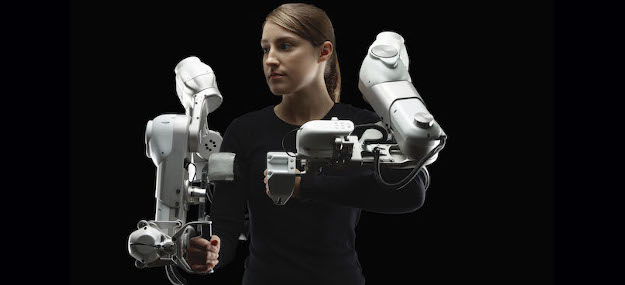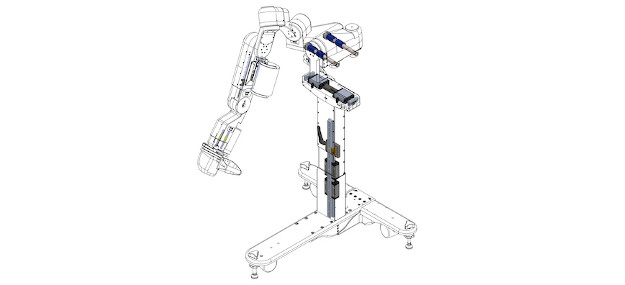
In Harmony
By Matt Mowry
Automation General MedicalAdjustable exoskeleton helps physical therapists shoulder stroke rehabilitation.

The Harmony exoskeleton, created by Harmonic Bionics, assists stoke patients heal neuromuscular damage and improve upper body functionality.
The pain lingered for about two weeks after the delivery, and she encountered vision problems and confusion in her speech. As it turned out, her health concerns were unrelated to her pregnancy. She was suffering a stroke, which occurs in approximately 30 women out of every 100,000 pregnancies in Canada.
Eva’s story is part of a growing trend in Canada, where stroke is the third-leading cause of death. According to heartandstroke.ca, more than 400,000 residents of Canada are living with long-term disability from stroke, a number expected to double in the next 20 years. About 60 percent of stroke patients are left with some disability, and more than 40 percent are left with moderate to severe disability.
Stroke patients who require extensive therapy are getting an assist from technology. Harmonic Bionics has designed an exoskeleton that tracks the full range of arm movement in 3D. The device, called Harmony, maximizes the range of motion of the human shoulder and the shoulder girdle while ensuring safety with physical and programmed interlocks. It allows physical therapists to work with stroke patients to improve the functionality and healing from neuromuscular damage. Actuator and controller technology allows the Harmony exoskeleton to customize gravity compensation, assistance and impedance as needed for the patient.
“Development of robust closed-loop torque-controlled actuators with high refresh rates was our biggest challenge,’’ said Rohit John Varghese, Harmonic’s Head of Product Development. “The design team built out all of the motor control and communication electronics in-house, and this has enabled the level of performance that the therapist who we work with require.”
Innovative shoulder mechanism
Harmony’s critical piece is an innovative shoulder mechanism that powers coordinated motions of five joints in the shoulder complex, which is the key to shoulder rehabilitation according to Professor Ashish Deshpande, director of the ReNeu Robotics Lab where the project was conceived.
Ensuring alignment between the exoskeleton and the patient is critical to prevent stress on the patient’s joints and protect them from injury. The project began in the ReNeu Robotics Lab at the University of Texas’ Cockrell School of Engineering in 2011 with funding from the National Science Foundation.

With a 5 degree-of-freedom shoulder joint, Harmony incorporates igus’ iglide J bearings, drylin T-rail guides and drylin R liner to provide maintenance- and lubrication-free motion and reduce the rehabilitation robot’s weight.
To be effective in a clinical setting, it is important for the exoskeleton to quickly and smoothly change its physical dimensions to align with these different body sizes.
“Our target is to get stroke patients moving the hemiparetic arm more efficiently and fluidly which leads to improved function and outcomes,’’ said Bob Whitford, an Occupational Therapist at St. David’s Medical Center in Texas. “Increasing the functional range of movement in preparation for furthering and completion is always the goal with our neuro-injured clients.”
In addition, due to the challenging requirements of human robot interaction, the resizing mechanisms need to be highly compact to allow for room for the electronics and actuators. All linear bearing mechanisms need to be able to lock once in position to prevent unwanted changes in size. Oil-based lubrication for the linear bearings causes many issues, including the accumulation of dirt, which allows for bacteria to accumulate.
Lightweight and maintenance-free
Harmony includes multiple bearings, liners and rail guides manufactured by igus, the Germany-based manufacturer of motion plastics. Besides being maintenance- and lubrication-free, the components are also extraordinarily light, an important criterion in an exoskeleton.
Each Harmony unit includes six iglide J bearings, an endurance bushing that exhibits low wear against different shaft materials and low coefficients of friction in dry operation. They are cost-effective bearings when low-pressure loads are needed and are frequently used in automation, printing, beverage technology and aerospace engineering.
The company’s drylin T-rail guide systems are manufactured to ensure high rigidity in the stand for the exoskeleton and are resistant to dirt and offer a low coefficient of friction and wear. They are also frequently used in machine building, machine tools, packaging and woodworking industries.
A custom bearing housing compresses on a drylin R liner, which reduced the size significantly compared to previous models of the exoskeleton. Compression from the housing locks shafts, eliminating the need for an additional shaft collar. drylin R products are made with the iglide J materials, and are frequently used in packaging, 3D printing and laboratories. The shoulder mechanism also includes drylin R bearings, which operate dry and tolerate frequent cleanings.
The Harmony engineering team worked extensively with igus representative Charles McNeil to identify the parts that best solved the needs for Harmony.
“Having the devices in our hands made it a lot more intuitive to find many more uses for them in our design,’’ Varghese said.
Stroke of luck
Eva Maragkakis survived her stroke in large part due to her body awareness and quick-thinking. She works full-time and doctors closely monitor her blood pressure and other risk factors associated with stroke.
But Canada, and the world, is fighting a growing health concern. According to the World Health Organization, about 15 million people suffer strokes each year. Stroke rates climbed 11 percent in Canada between 2006-2015 for people between the ages 20-59. The increase is tied to more processed foods, stressful lives, sedentary lifestyles and higher rates of obesity and diabetes in young adults.
While the Harmony exoskeleton won’t prevent stroke, it will help patients who remain committed to the rehabilitation process to improve functionality and improve their quality of life.
“The biggest challenge with stroke survivors is the duration of time required to re-train the brain to a function level and the patience required by the survivor to persist in their own rehab journey,” Whitford said. “Many patients give up too soon or develop bad habits that will persist for the rest of their lives. Harmony helps make my job easier to handle the patient’s upper limb paralysis and gives immediate feedback.”
http://harmonicbionics.com
www.igus.ca
Matt Mowry is the DryLin Product Manager for igus North America.
